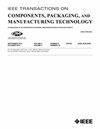Effect of Ultrasound on the Reliability of Ni/Sn/Ni Micro Copper Pillar Solder Joints
IF 2.3
3区 工程技术
Q2 ENGINEERING, ELECTRICAL & ELECTRONIC
IEEE Transactions on Components, Packaging and Manufacturing Technology
Pub Date : 2025-01-31
DOI:10.1109/TCPMT.2025.3537341
引用次数: 0
Abstract
As the interconnection density of chips continues to increase, the reliability of solder joints under complex working conditions has become increasingly prominent. Therefore, altering the interfacial microstructure of solder joints to enhance their reliability has become a crucial direction in the study of chip service reliability. The research investigates the regulation of ultrasonic treatment on the electromigration (EM) resistance, thermal aging resistance, and the performance under thermoelectric coupling of microcopper pillar solder joints. It analyzes the corresponding failure modes, the growth behavior of intermetallic compounds (IMCs), and the influence of求助全文
约1分钟内获得全文
求助全文
来源期刊

IEEE Transactions on Components, Packaging and Manufacturing Technology
ENGINEERING, MANUFACTURING-ENGINEERING, ELECTRICAL & ELECTRONIC
CiteScore
4.70
自引率
13.60%
发文量
203
审稿时长
3 months
期刊介绍:
IEEE Transactions on Components, Packaging, and Manufacturing Technology publishes research and application articles on modeling, design, building blocks, technical infrastructure, and analysis underpinning electronic, photonic and MEMS packaging, in addition to new developments in passive components, electrical contacts and connectors, thermal management, and device reliability; as well as the manufacture of electronics parts and assemblies, with broad coverage of design, factory modeling, assembly methods, quality, product robustness, and design-for-environment.
 求助内容:
求助内容: 应助结果提醒方式:
应助结果提醒方式:


